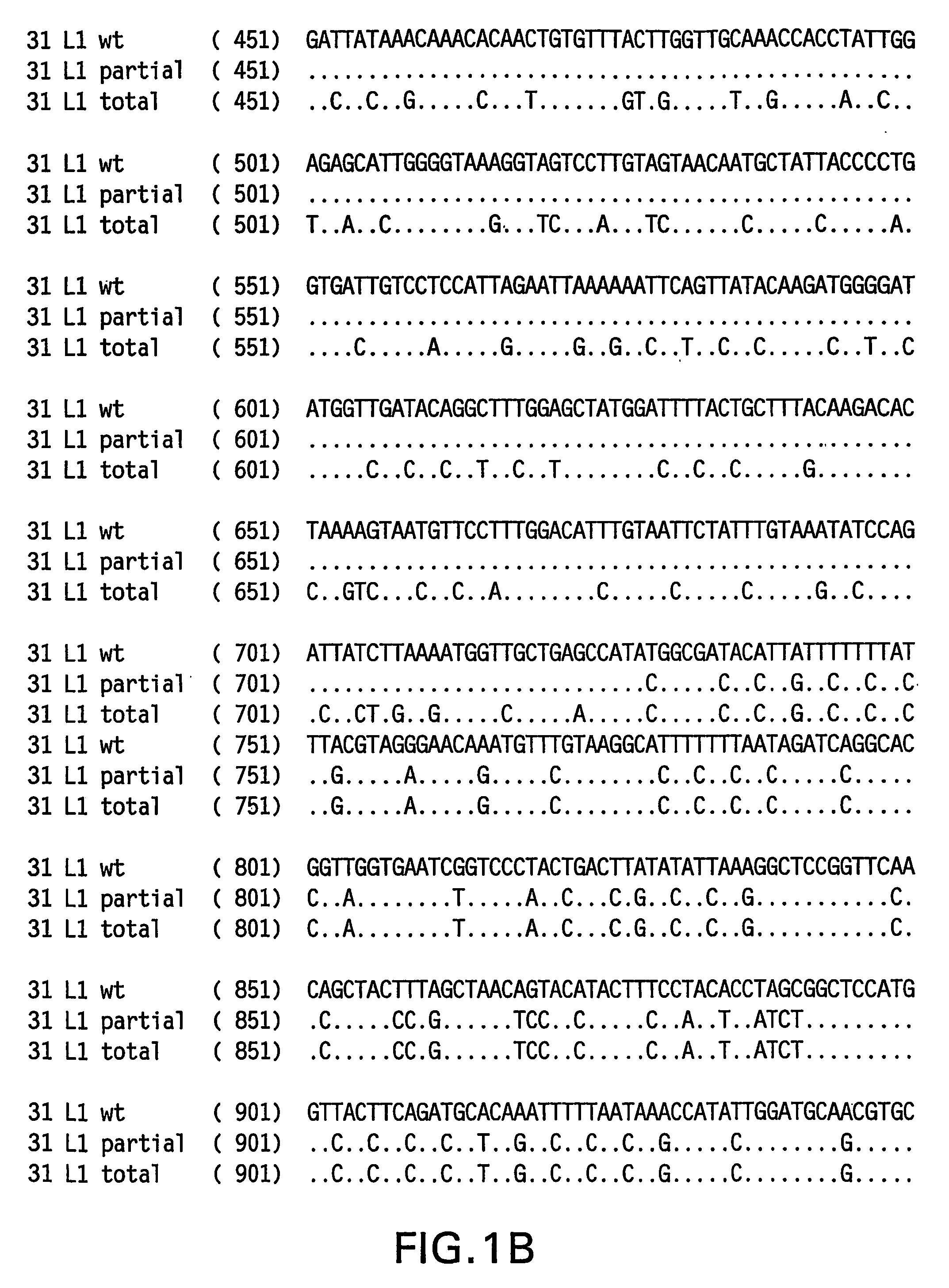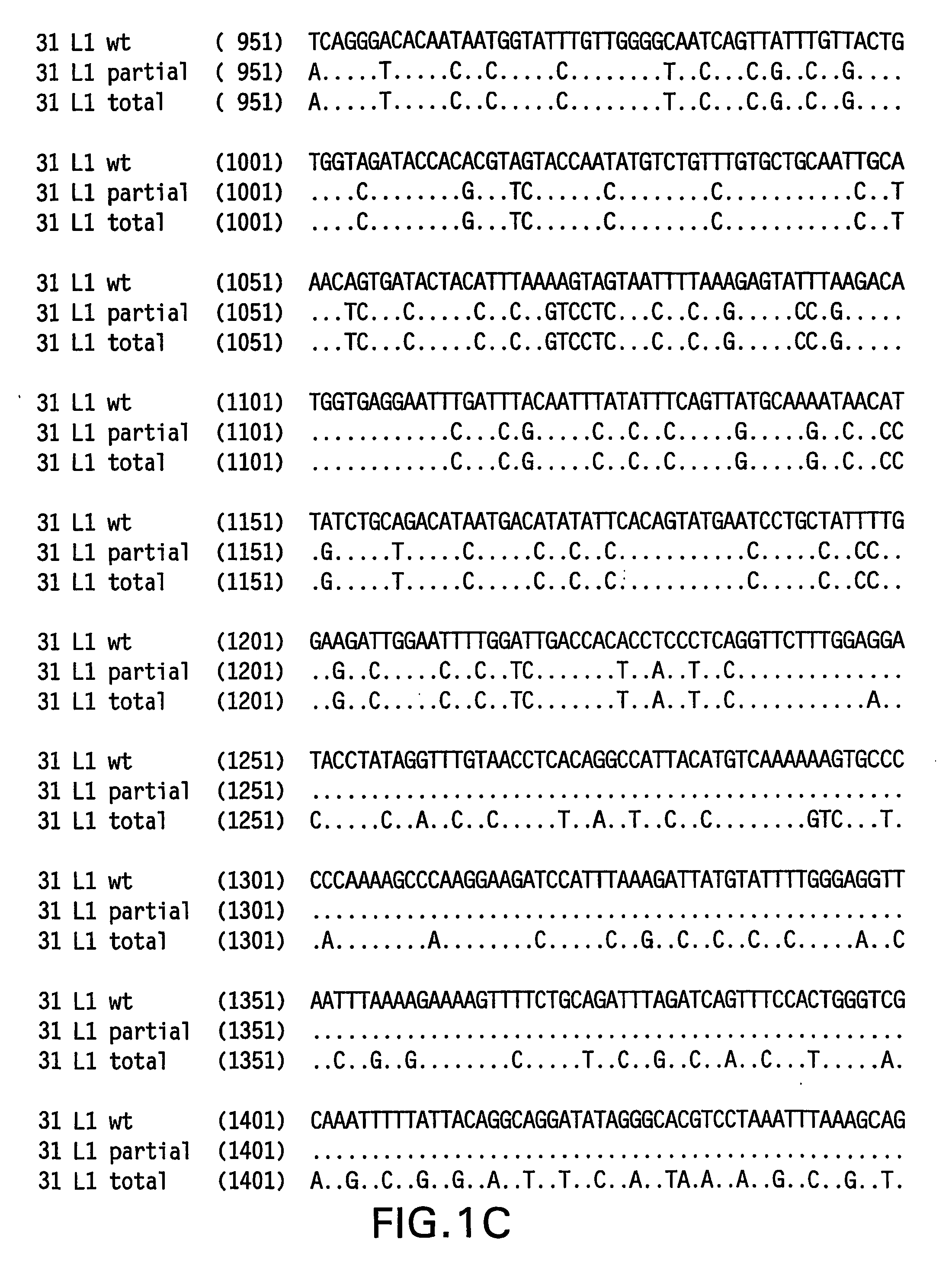Codon-optimized papilloma virus sequences
a technology of papilloma virus and sequence, which is applied in the field of synthetic polynucleotides encoding hpv31 l1 protein, can solve the problems of limiting the production of purified proteins, development and commercialization
- Summary
- Abstract
- Description
- Claims
- Application Information
AI Technical Summary
Benefits of technology
Problems solved by technology
Method used
Image
Examples
example 1
Determination of a Representative HPV 31 L1 Sequence
[0084] The HPV 31 L1 wild-type sequence has been described previously (Goldsborough et al., Virology 171(1): 306-311 (1989); Genbank Accession # 304353). It is not uncommon, however, to find minor sequence variations between DNAs obtained from clinical isolates. To isolate a representative HPV31 L1 wild-type sequence, DNA was isolated from three clinical samples previously shown to contain HPV 31 DNA. HPV 31 L1 sequences were amplified in a polymerase chain reaction (PCR) using Taq DNA polymerase and the following primers: HPV 31 L1 F 5′-CGT CGA CGT AAA CGT GTA TCA TAT TTT TTT ACA G-3′ (SEQ ID NO:5) and HPV 31 L1 B 5′-CAG ACA CAT GTA TTA CAT ACA CAA C-3′ (SEQ ID NO:6). The amplified products were electrophoresed on agarose gels and visualized by ethidium bromide staining. The ˜1500 bp L1 bands were excised and DNA purified using the QIA quick PCR purification kit (Qiagen, Hilden, Germany). The DNA was then ligated to the TA cloni...
example 2
[0088] Yeast-preferred codons have been described (Sharp and Cowe, Yeast 7: 657-678 (1991)). Initially, the middle portion of HPV 31 L1, representing nucleotides 697-1249, was rebuilt utilizing yeast-preferred codons. The strategy employed to rebuild was to design long overlapping sense and antisense oligomers that span the region to be rebuilt, substituting nucleotides with yeast-preferred codon sequences while maintaining the same amino acid sequence. These oligomers were used in place of template DNA in the PCR reaction. Additional amplification primers were designed and used to amplify the rebuilt sequences from template oligomers with Pfu DNA polymerase (Stratagene, La Jolla, Calif.). The optimal conditions for amplification were section-specific; however, most employed a program resembling the following: an initial denaturation step of 94° C. for 1 minute, followed by 15-25 cycles of 95° C. for 30 sec denature, 55° C. for 30 sec anneal, 72° C. for 3.5...
example 3
RNA Preparation
[0092] Cell pellets of transformed yeast, which were induced to express HPV 31 L1 by galactose induction, were thawed on ice and suspended in 1 ml of cold DEPC-treated water. Cells were pelleted by centrifugation and the resulting supernatant was removed. The cell pellet was then resuspended in 400 μl TES (10 mM Tris pH7.0, 10 mM EDTA and 0.5% SDS). An equal volume of AE buffer-saturated phenol (50 mM NaOAc and 10 mM EDTA) was added. The tube was vortexed for 10 seconds and heated to 65° C. for 50 minutes with mixing every 10 minutes. The tube was then placed on ice for 5 minutes, followed by centrifugation at 4° C. for 5 minutes. The supernatant was collected and transferred to a sterile tube. An additional 400 μl of phenol was added, the tube vortexed, placed on ice for 5 minutes and centrifuged. The supernatant was transferred to a sterile tube and 400 μl of chloroform added, mixed and centrifuged. The supernatant was again collected and transferred to a sterile ...
PUM
| Property | Measurement | Unit |
|---|---|---|
| Immunogenicity | aaaaa | aaaaa |
Abstract
Description
Claims
Application Information
 Login to View More
Login to View More - Generate Ideas
- Intellectual Property
- Life Sciences
- Materials
- Tech Scout
- Unparalleled Data Quality
- Higher Quality Content
- 60% Fewer Hallucinations
Browse by: Latest US Patents, China's latest patents, Technical Efficacy Thesaurus, Application Domain, Technology Topic, Popular Technical Reports.
© 2025 PatSnap. All rights reserved.Legal|Privacy policy|Modern Slavery Act Transparency Statement|Sitemap|About US| Contact US: help@patsnap.com



